Predicting Net Returns of Organic and Conventional Strawberry Following Soil Disinfestation with Steam or Steam Plus Additives
Abstract
1. Introduction
Previous Literature
2. Materials and Methods
2.1. Field Trials
2.1.1. Production System and Timing
2.1.2. Treatments
2.2. Economic Data and Methods
2.3. ANOVA and Regression Analysis
2.4. Predictive Analysis
3. Results
3.1. Descriptive Statistics
3.1.1. Heat Variables: Heat Duration and Maximum Temperature
3.1.2. Yield
3.1.3. Costs
3.1.4. Net Returns
3.2. ANOVA
3.3. Linear Regression
3.4. Predicting Net Returns as a Function of Maximum Temperature and Heat Duration
3.4.1. Single Variable Analysis
3.4.2. Joint Analysis
3.4.3. Predicting Net Returns by Treatment
3.4.4. Net Returns at Mean Maximum Temperature and Heat Duration
3.4.5. Net Return-Maximizing Maximum Temperature and Heat Duration
4. Discussion
5. Conclusions
Supplementary Materials
Author Contributions
Funding
Institutional Review Board Statement
Informed Consent Statement
Data Availability Statement
Acknowledgments
Conflicts of Interest
References
- Xu, Y.; Goodhue, R.; Chalfant, J.; Miller, T.; Fennimore, S. Economic viability of steam as an alternative to pre-plant soil fumigation in California strawberry production. HortScience 2017, 52, 401–407. [Google Scholar] [CrossRef]
- Bolda, M.P.; Tourte, L.; Klonsky, K.M.; De Moura, R.L.; Tumber, K.P. Sample Costs to Produce Organic Strawberries, Central Coast. 2014. Available online: https://coststudyfiles.ucdavis.edu/uploads/cs_public/94/4b/944b5aad-6660-4dcd-a449-d26361afcae2/strawberry-cc-organic-2014.pdf (accessed on 6 January 2021).
- Subbarao, K.V.; Kabir, Z.; Martin, F.N.; Koike, S.T. Management of soilborne diseases in strawberry using vegetable rotations. Plant Dis. 2007, 91, 964–972. [Google Scholar] [CrossRef] [PubMed]
- Koike, S.T. Crown Rot of Strawberry Caused by Macrophomina phaseolina in California. Plant Dis. 2008, 92, 1253. [Google Scholar] [CrossRef] [PubMed]
- Kim, D.S.; Hoffmann, M.; Kim, S.; Scholler, B.A.; Fennimore, S.A. Integration of steam with allyl-isothiocyanate for soil disinfestation. HortScience 2020, 1–6, in preparation. [Google Scholar]
- Senner, A.H. Application of Steam in the Sterilization of Soils; US Department of Agriculture: Washington, DC, USA, 1934; 20p.
- Shennan, C.; Muramoto, J.; Koike, S.; Baird, G.; Fennimore, S.; Samtani, J.; Bolda, M.; Dara, S.; Daugovish, O.; Lazarovits, G.; et al. Anaerobic soil disinfestation is an alternative to soil fumigation for control of some soilborne pathogens in strawberry production. Plant Pathol. 2018, 67, 51–66. [Google Scholar] [CrossRef]
- Muramoto, J.; Gliessman, S.R.; Koike, S.T.; Shennan, C.; Bull, C.T.; Klonsky, K.; Swezey, S. Integrated biological and cultural practices can reduce crop rotation period of organic strawberries. Agroecol. Sustain. Food Syst. 2014, 38, 603–631. [Google Scholar] [CrossRef]
- Fennimore, S.A.; Goodhue, R.E. Soil disinfestation with steam: A review of economics, engineering and soil pest control in California strawberry. Int. J. Fruit Sci. 2016, 16, 71–83. [Google Scholar] [CrossRef]
- Fennimore, S.A.; Serohijos, R.; Samtani, J.B.; Ajwa, H.A.; Subbarao, K.V.; Martin, F.N.; Daugovish, O.; Legard, D.; Browne, G.T.; Muramoto, J.; et al. TIF film, substrates and nonfumigant soil disinfestation maintain fruit yields. Calif. Agric. 2013, 67, 139–146. [Google Scholar] [CrossRef]
- Miller, T.C.; Samtani, J.B.; Fennimore, S.A. Mixing steam with soil increases heating rate compared to steam applied to still soil. Crop. Prot. 2014, 64, 47–50. [Google Scholar] [CrossRef]
- Dabbene, F.; Gay, P.; Tortia, C. Modelling and control of steam soil disinfestation processes. Biosyst. Eng. 2003, 84, 247–256. [Google Scholar] [CrossRef]
- Gay, P.; Piccarolo, P.; Aimonino, D.R.; Tortia, C. A high efficiency steam soil disinfestation system, part I: Physical background and steam supply optimisation. Biosyst. Eng. 2010, 107, 74–85. [Google Scholar] [CrossRef]
- Wei, H.; Goodhue, R.; Muramoto, J.; Sumner, D. Economic Statistics of California’s Organic Agriculture: 2013–2016; University of California Agricultural Issues Center: Davis, CA, USA, 2020; Available online: https://aic.ucdavis.edu/wp-content/uploads/2020/10/CA-Organic-Ag-13-16.pdf (accessed on 6 January 2021).
- Shennan, C.; Muramoto, J. Design and Management of Organic Strawberry/Vegetable Rotations. Ob-Tenido de CAL-CORE. 11 April 2016. Available online: https://calcorenetwork.sites.ucsc.edu/2016/04/03/design-and-management-of-organic-strawberryvegetable-rotations/ (accessed on 6 January 2021).
- McQueen, R.J.; Garner, S.R.; Nevill-Manning, C.G.; Witten, I.H. Applying machine learning to agricultural data. Comput. Electron. Agric. 1995, 12, 275–293. [Google Scholar] [CrossRef]
- Hoffmann, M.; Ajwa, H.A.; Westerdahl, B.B.; Koike, S.T.; Stanghellini, M.; Wilen, C.; Fennimore, S.A. Multi-tactic pre-plant soil fumigation with allyl isothiocyanate in cut-flower and strawberry. HortTechnology 2020. in print. [Google Scholar] [CrossRef]
- Michuda, A.; Goodhue, R.E.; Klonsky, K.; Baird, G.; Toyama, L.; Zavatta, M.; Muramoto, J.; Shennan, C. The economic viability of suppressive crop rotations for the control of verticillium wilt in organic strawberry production. Agroecol. Sustain. Food Syst. 2018, 43, 984–1008. [Google Scholar] [CrossRef]
- Hoffmann, M.; Barbella, A.; Miller, T.; Broome, J.; Martin, F.; Koike, S.; Rachuy, J.; Greene, I.; Dorn, N.; Goodhue, R.; et al. Weed and pathogen control with steam in California strawberry production. Acta Hortic. 2016, 1156, 593–602. [Google Scholar] [CrossRef]
- Liakos, K.G.; Busato, P.; Moshou, D.; Pearson, S.; Bochtis, D. Machine learning in agriculture: A review. Sensors 2018, 18, 2674. [Google Scholar] [CrossRef] [PubMed]
- Fennimore, S.A.; Martin, F.N.; Miller, T.C.; Broome, J.C.; Dorn, N.; Greene, I. Evaluation of a mobile steam applicator for soil disinfestation in California strawberry. HortScience 2014, 49, 1542–1549. [Google Scholar] [CrossRef]
- Lachenbruch, P.A.; Mickey, M.R. Estimation of error rates in discriminant analysis. Technometrics 1968, 10, 1–11. [Google Scholar] [CrossRef]
- Koike, S.T.; Kirkpatrick, S.C.; Gordon, T.R. Fusarium Wilt of Strawberry Caused by Fusarium oxysporum in California. Plant Dis. 2009, 93, 1077. [Google Scholar] [CrossRef]
- Daugovish, O.; Howell, A.; Fennimore, S.; Koike, S.; Gordon, T.; Subbarao, K. Non-fumigant treatments and their combinations affect soil pathogens and strawberry performance in southern California. Int. J. Fruit Sci. 2016, 16 (Suppl. S1), 37–46. [Google Scholar] [CrossRef]
- Atwood, D.; Paisley-Jones, C. Pesticides Industry Sales and Usages 2008–2012 Market Estimates; Office Pesticide Programs, Office Chem. Safety Poll. Prev., U.S. Environ. Protection Agency: Washington, DC, USA, 2017.
- Bolda, M.P.; Tourte, L.; Murdock, J.; Sumner, D.A. Sample Costs to Produce and Harvest Strawberries, Central Coast Region. 2016. Available online: https://coststudyfiles.ucdavis.edu/uploads/cs_public/e7/6d/e76dceb8-f0f5-4b60-bcb8-76b88d57e272/strawberrycentralcoast-2016-final2-5-1-2017.pdf (accessed on 6 January 2021).
- Inderbitzin, P.; Ward, J.; Barbella, A.; Solares, N.; Izyumin, D.; Burman, P.; Chellemi, D.O.; Subbarao, K.V. Soil microbiomes associated with Verticillium wilt-suppressive broccoli and chitin amendments are enriched with potential bio-control agents. Phytopathology 2018, 108, 31–43. [Google Scholar] [CrossRef] [PubMed]
- Samtani, J.B.; Gilbert, C.; Weber, J.B.; Subbarao, K.V.; Goodhue, R.E.; Fennimore, S.A. Effect of steam and solarization treatments on pest control, strawberry yield, and economic returns relative to methyl bromide fumigation. HortScience 2012, 47, 64–70. [Google Scholar] [CrossRef]
- California Department of Food and Agriculture. California Agricultural Statistics Review, 2018–2019; California Department of Food and Agriculture: Sacramento, CA, USA, 2019. Available online: https://www.cdfa.ca.gov/statistics/PDFs/2018-2019AgReportnass.pdf (accessed on 6 January 2021).
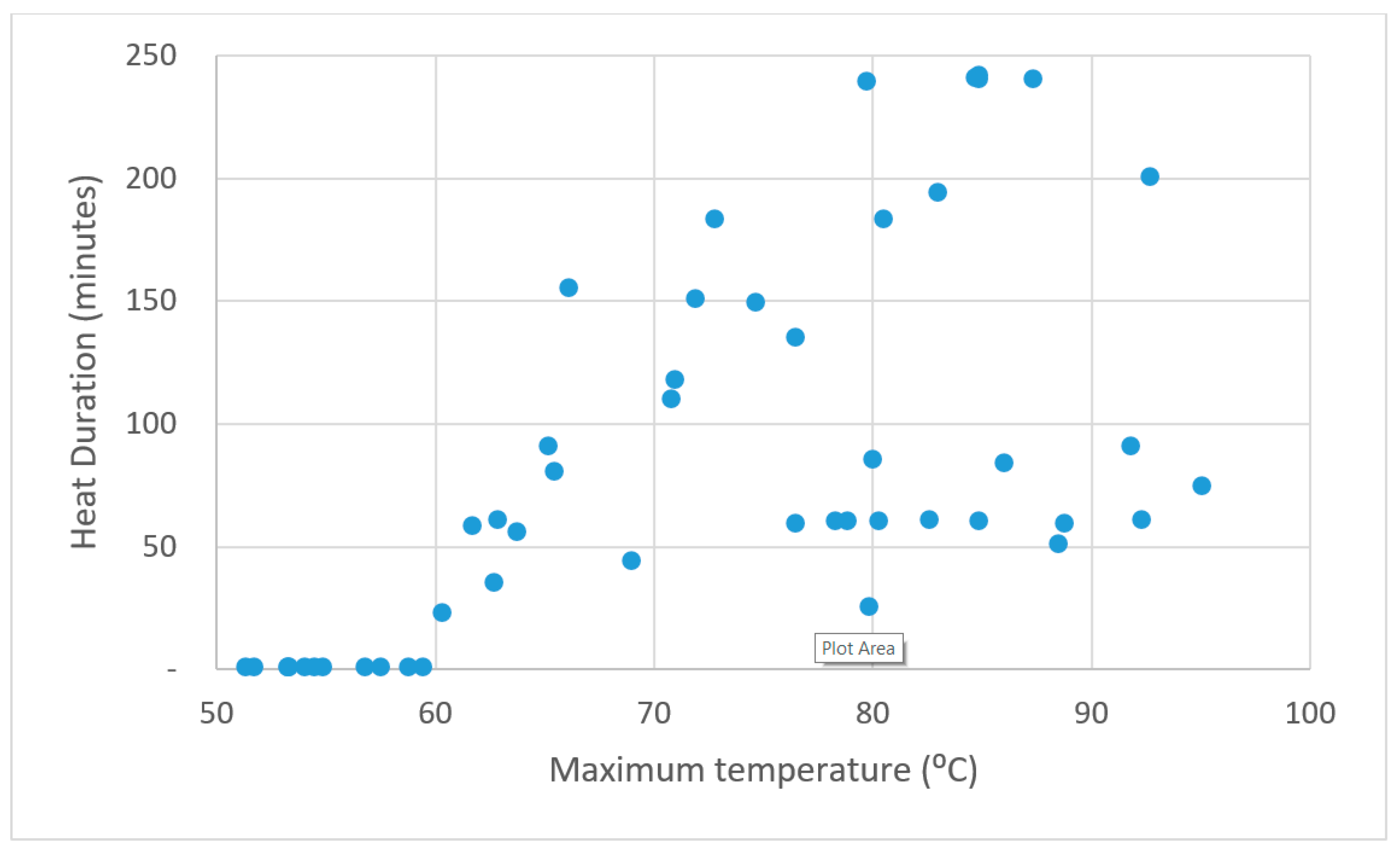
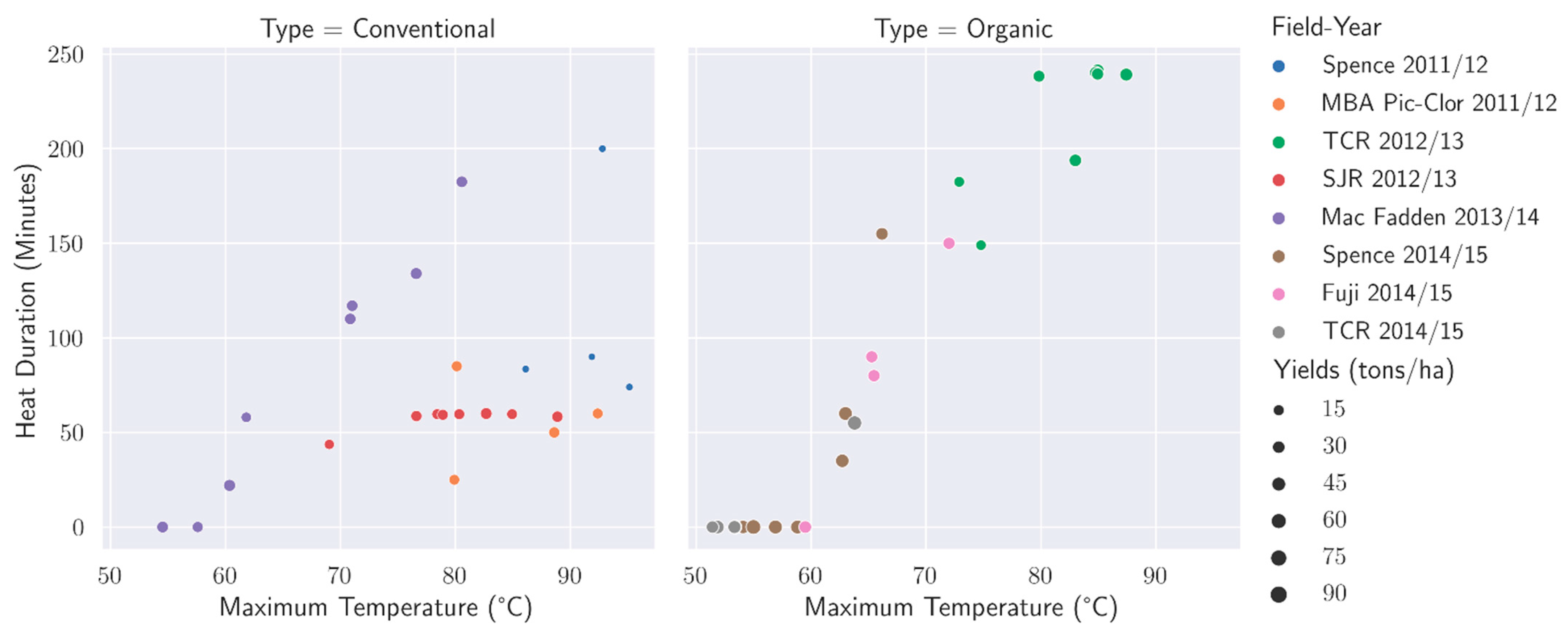
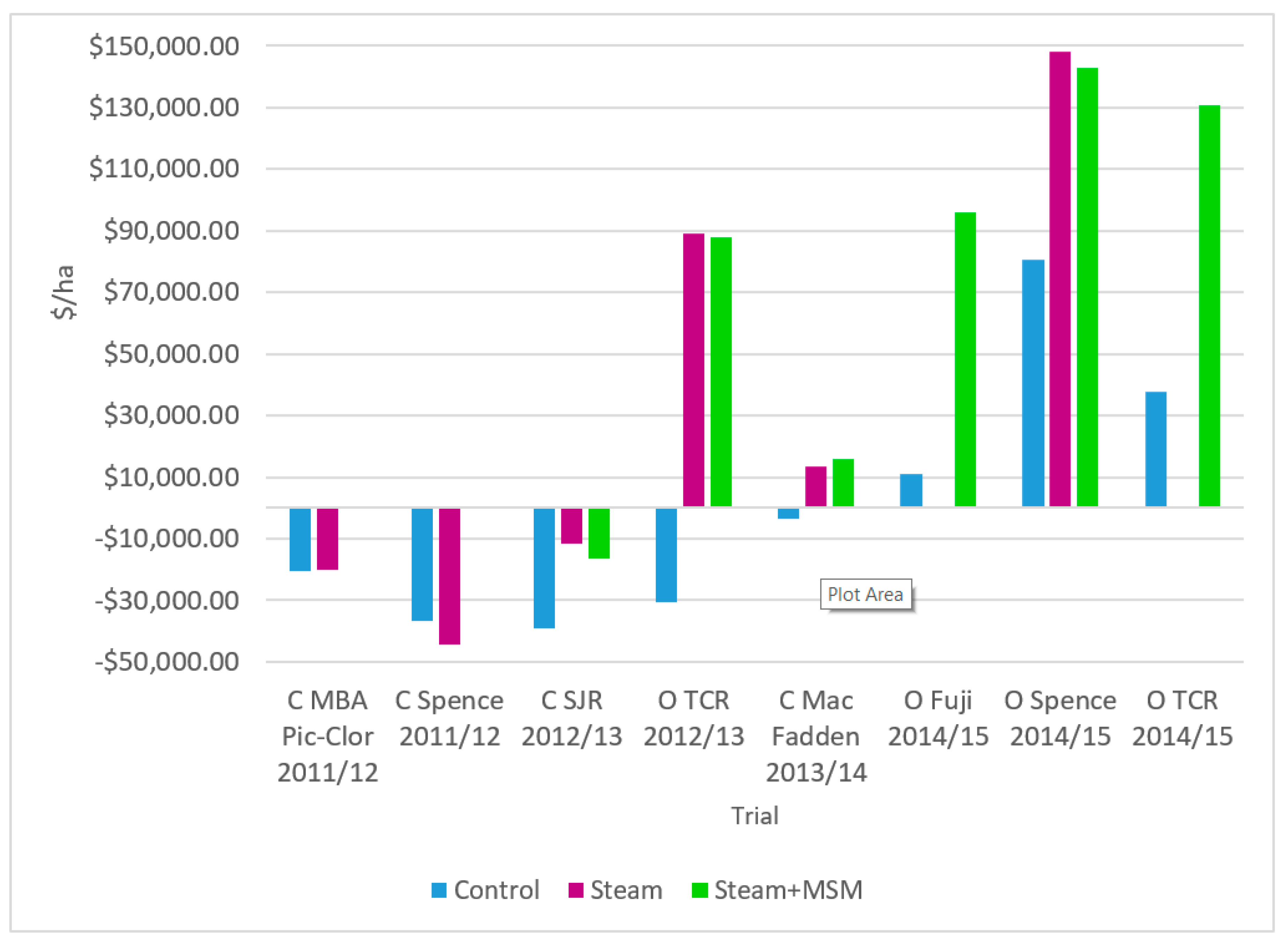
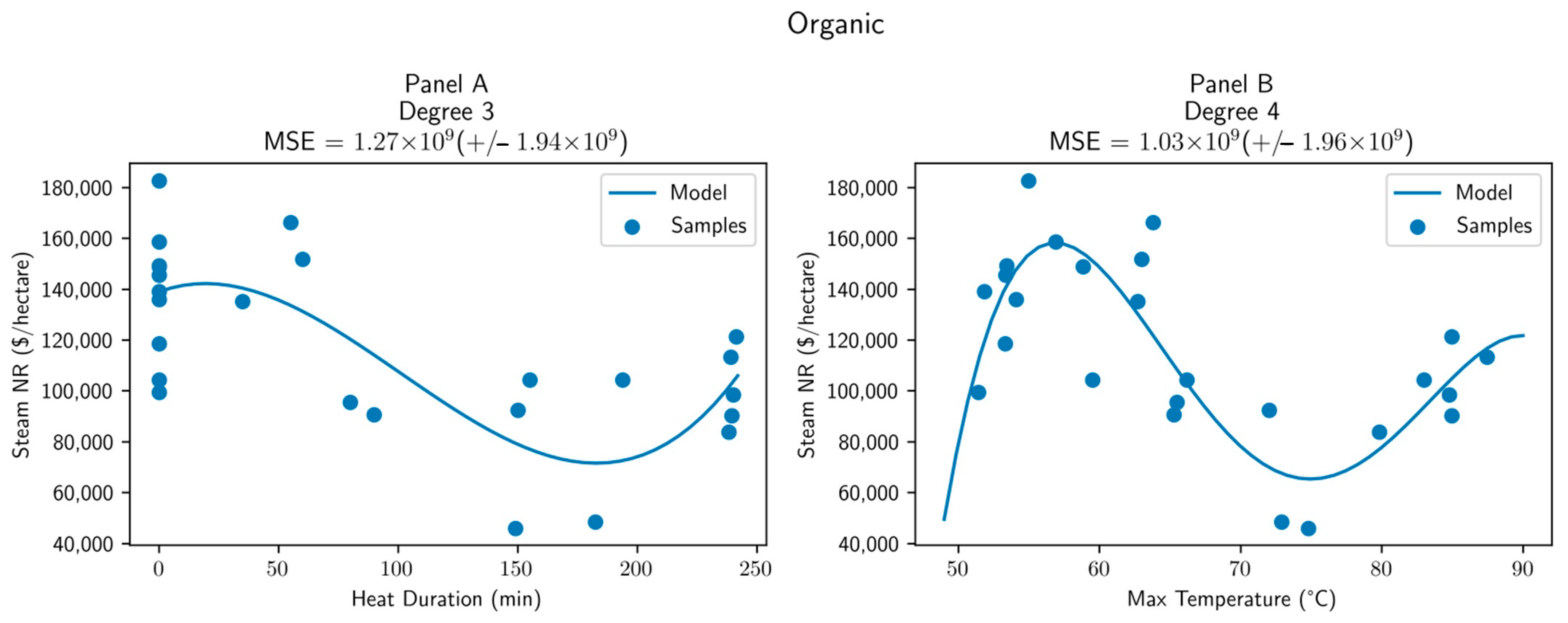
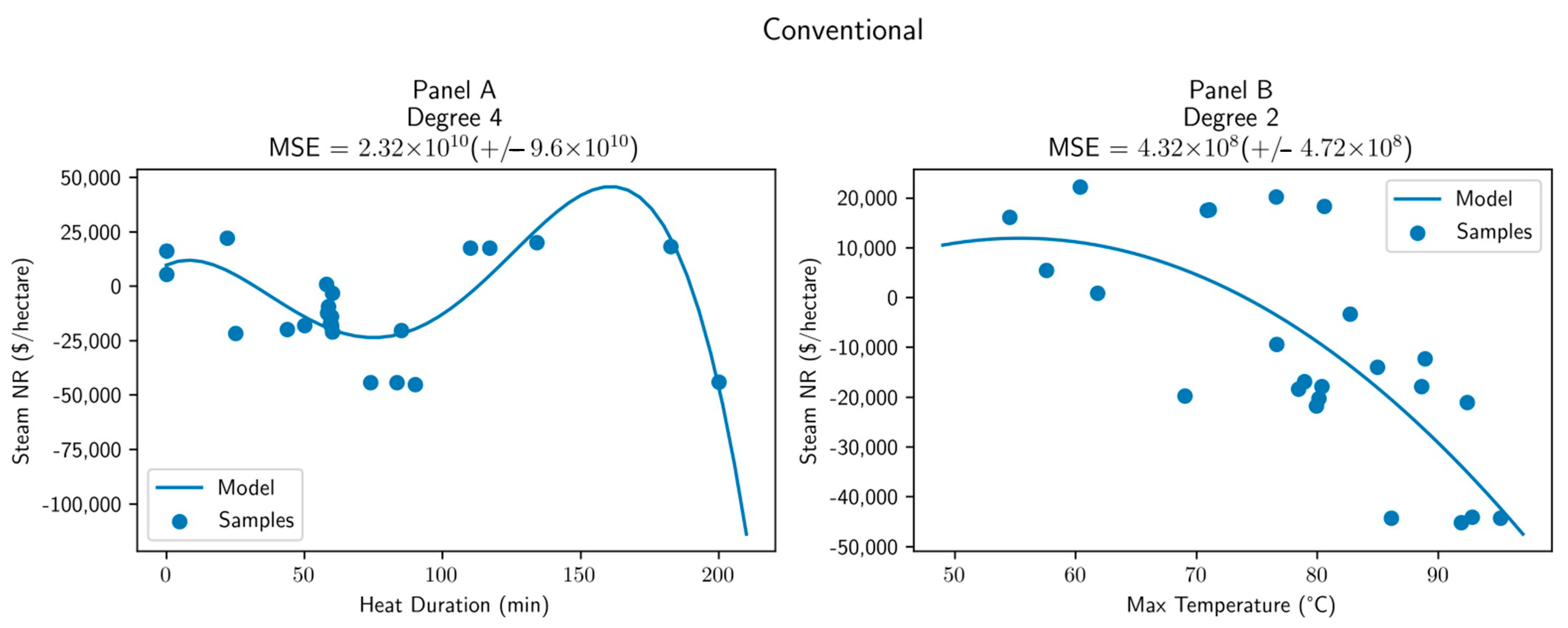


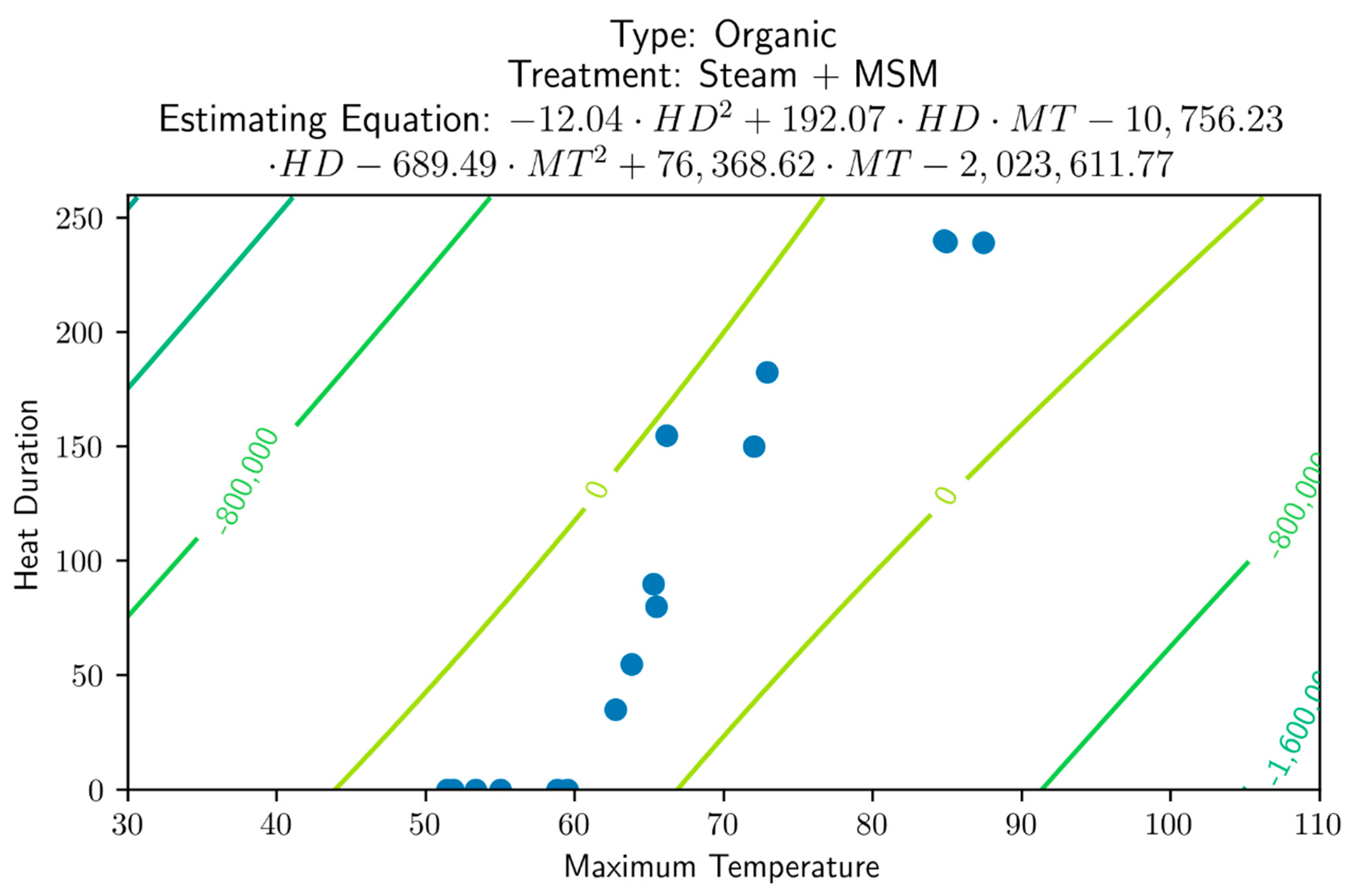

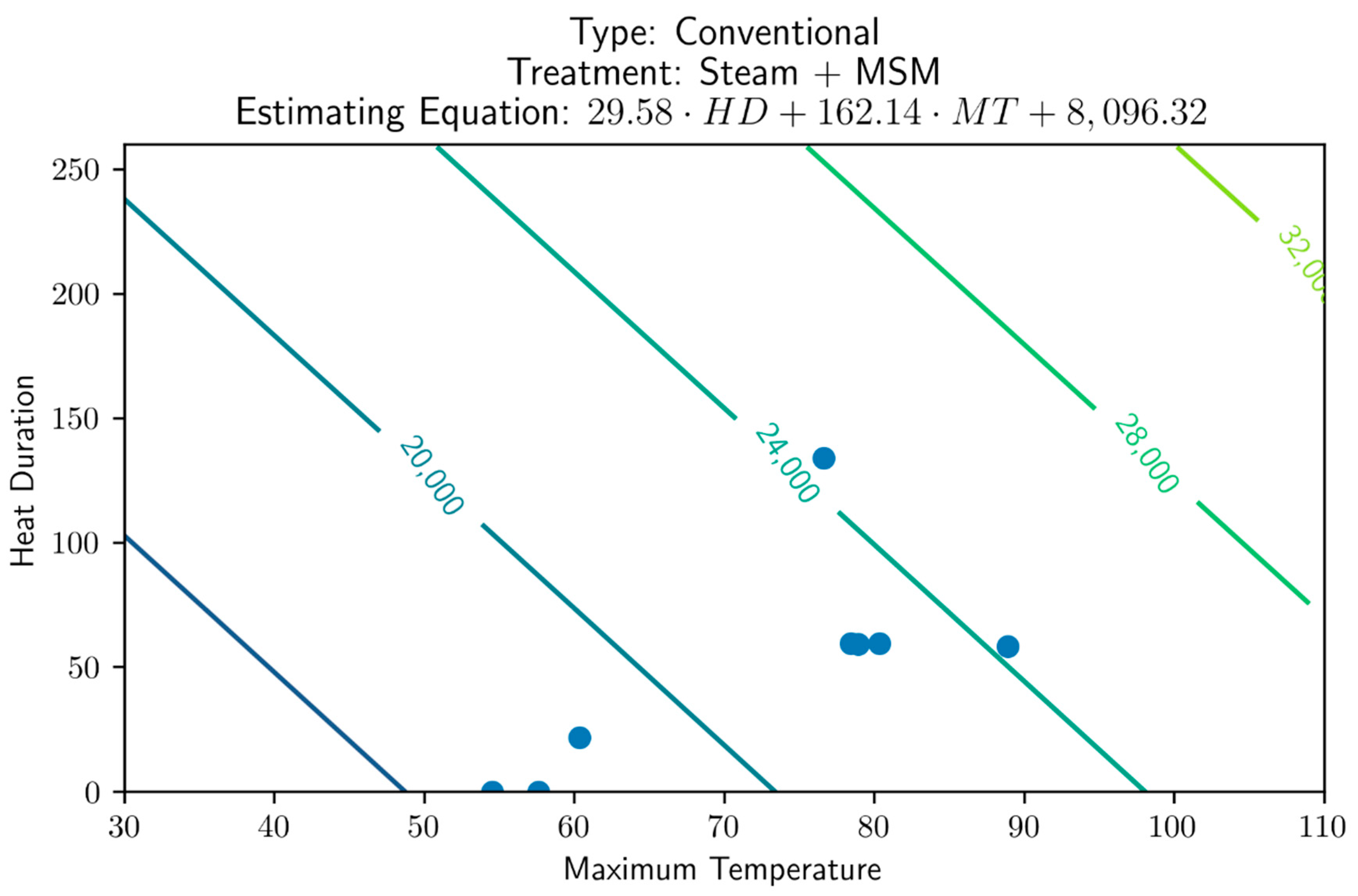
| Trial (Season) | Production System | Steam Included | Steam + MSM Included (MSM Rate) |
|---|---|---|---|
| MBA (2011/12) | Conventional | Yes | No |
| Spence (2011/12) | Conventional | Yes | No |
| SJR (2012/13) | Conventional | Yes | Yes (3368 kg ha−1 pelletized MSM) |
| TCR (2012/13) | Organic | Yes | Yes (3368 kg ha−1 pelletized MSM) |
| MacFadden (2013/14) | Conventional | Yes | Yes (3368 kg ha−1 pelletized MSM) |
| Fuji (2014/15) | Organic | No | Yes (2245 kg ha−1 pelletized MSM) |
| Spence (2014/15) | Organic | Yes | Yes (2245 kg ha−1 pelletized MSM) |
| TCR (2014/15) | Organic | No | Yes (2245 kg ha−1 pelletized MSM) |
| Treatment | Replicates | Maximum Temperature (°C) | Heat Duration (Minutes) | ||
|---|---|---|---|---|---|
| Mean | Standard Deviation | Mean | Standard Deviation | ||
| Conventional | |||||
| Steam | 16 | 81.5 | 9.7 | 84.8 | 47.9 |
| Steam + MSM | 8 | 71.9 | 12.6 | 49.1 | 43.4 |
| Organic | |||||
| Steam | 9 | 67.0 | 13.5 | 98.1 | 107.2 |
| Steam + MSM | 16 | 66.0 | 11.7 | 91.6 | 95.4 |
| Treatment | Trials | Replicates | Mean | Standard Deviation | Coefficient of Variation |
|---|---|---|---|---|---|
| Conventional | |||||
| Control | 4 | 24 | 27.0 | 11.0 | 0.4 |
| Steam | 4 | 16 | 33.1 | 16.0 | 0.47 |
| Steam + MSM | 2 | 8 | 44.9 | 6.1 | 0.13 |
| Organic | |||||
| Control | 4 | 25 | 44.6 | 14.8 | 0.32 |
| Steam | 2 | 9 | 70.4 | 14.4 | 0.19 |
| Steam + MSM | 4 | 16 | 68.8 | 13.0 | 0.18 |
| Production System | Conventional | Organic | ||||
|---|---|---|---|---|---|---|
| Cultural Cost | Harvest Cost | Treatment Cost | Cultural Cost | Harvest Cost | Treatment Cost | |
| Treatment | ||||||
| Control | 37,472 (0.38) | 60,069 (0.62) | 0 (0.00) | 38,468 (0.23) | 126,191 (0.77) | 0 (0.00) |
| Steam | 37,472 (0.36) | 53,708 (0.52) | 12,355 (0.12) | 38,484 (0.22) | 127,990 (0.72) | 12,355 (0.07) |
| Steam + MSM | 37,472 (0.29) | 72,792 (0.57) | 17,139 (0.13) | 38,459 (0.21) | 125,178 (0.69) | 17,139 (0.09) |
| Control | Steam | Steam + MSM | |
|---|---|---|---|
| Conventional | |||
| MacFadden 2013/14 | −3591 (A) | 13,630 (B) | 16,037 (B) |
| MBA Pic-Clor 2011/12 | −20,570 (A) | −20,179 (B) | |
| SJR 2012/13 | −39,107 (A) | −11,571 (B) | −16,303 (B) |
| Spence 2011/12 | −36,827 (A) | −44,433 (A) | |
| Organic | |||
| Fuji 2014/15 | 11,174 (A) | 95,803 (B) | |
| Spence 2014/15 | 80,554 (A) | 148,256 (B) | 142,806 (B) |
| TCR 2012/13 | −30,667 (A) | 88,909 (B) | 87,714 (B) |
| TCR 2014/15 | 37,804 (A) | 130,872 (B) | |
| Treatment | Net Returns | Groups |
|---|---|---|
| Organic | ||
| Steam | 121,880 | A |
| Steam + MSM | 114,299 | A |
| Control | 27,023 | B |
| Conventional | ||
| Steam + MSM | −133 | A |
| Steam | −16,638 | B |
| Control | −23,799 | C |
| Coefficient | Standard Error | t Stat | p-Value | |
|---|---|---|---|---|
| Intercept | 39,719 | 9102 | 4.36 | 7.62 × 10−5 |
| Steam | 91,369 | 9414 | 9.71 | 1.67 × 10−12 |
| Steam + MSM | 89,239 | 7612 | 11.72 | 3.98 × 10−15 |
| Fuji 2014/15 | −30,849 | 11,693 | −2.64 | 0.01 |
| Spence 2014/15 | 28,264 | 10,353 | 2.73 | 9.08 × 10−3 |
| TCR 2012/13 | −56,048 | 10,459 | −5.36 | 2.92 × 10−6 |
| Adj. | 0.86 | |||
| DW | 1.98 | |||
| JB | 0.405 | |||
| Cond. No. | 6.51 |
| Coefficient | Standard Error | t Stat | p-Value | |
|---|---|---|---|---|
| Intercept | −46,251 | 3548 | −13.03 | 2.36 × 10−16 |
| Steam | 11,242 | 2981 | 3.77 | 5.03 × 10−4 |
| Steam + MSM | 17,503 | 3849 | 4.55 | 4.55 × 10−5 |
| MacFadden 2013/14 | 44,686 | 4082 | 10.94 | 7.04 × 10−15 |
| MBA Pic-Clor 2011/12 | 20,255 | 4554 | 4.45 | 6.25 × 10−5 |
| SJR 2012/13 | 12,543 | 4082 | 3.07 | 3.72 × 10−3 |
| Adj. | 0.81 | |||
| DW | 1.02 | |||
| JB | 0.90 | |||
| Cond. No. | 6.37 |
| Degree of Polynomial | Average Mean Square Error | |
|---|---|---|
| Organic | Conventional | |
| 1 | 5.52 × 109 | 4.22 × 109 |
| 2 | 2.53 × 109 | 3.08 × 109 |
| 3 | 1.02 × 1010 | 3.42 × 109 |
| 4 | 2.82 × 1011 | 4.76 × 109 |
| 5 | 2.69 × 1016 | 8.47 × 1011 |
| 6 | 3.72 × 1016 | 2.20 × 1015 |
| Treatment | Difference in Net Returns ha−1 * | Net Returns ha−1 ** |
|---|---|---|
| All organic | 77,393 | 104,404 |
| Organic, steam only | 90,642 | 117,654 |
| Organic, steam + MSM only | 88,120 | 115,132 |
| All conventional | 13,494 | −10,295 |
| Conventional, steam only | 9013 | −14,776 |
| Conventional, steam + MSM | 21,212 | −2579 |
Publisher’s Note: MDPI stays neutral with regard to jurisdictional claims in published maps and institutional affiliations. |
© 2021 by the authors. Licensee MDPI, Basel, Switzerland. This article is an open access article distributed under the terms and conditions of the Creative Commons Attribution (CC BY) license (http://creativecommons.org/licenses/by/4.0/).
Share and Cite
Michuda, A.; Goodhue, R.E.; Hoffmann, M.; Fennimore, S.A. Predicting Net Returns of Organic and Conventional Strawberry Following Soil Disinfestation with Steam or Steam Plus Additives. Agronomy 2021, 11, 149. https://doi.org/10.3390/agronomy11010149
Michuda A, Goodhue RE, Hoffmann M, Fennimore SA. Predicting Net Returns of Organic and Conventional Strawberry Following Soil Disinfestation with Steam or Steam Plus Additives. Agronomy. 2021; 11(1):149. https://doi.org/10.3390/agronomy11010149
Chicago/Turabian StyleMichuda, Aleksandr, Rachael E. Goodhue, Mark Hoffmann, and Steven A. Fennimore. 2021. "Predicting Net Returns of Organic and Conventional Strawberry Following Soil Disinfestation with Steam or Steam Plus Additives" Agronomy 11, no. 1: 149. https://doi.org/10.3390/agronomy11010149
APA StyleMichuda, A., Goodhue, R. E., Hoffmann, M., & Fennimore, S. A. (2021). Predicting Net Returns of Organic and Conventional Strawberry Following Soil Disinfestation with Steam or Steam Plus Additives. Agronomy, 11(1), 149. https://doi.org/10.3390/agronomy11010149





